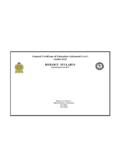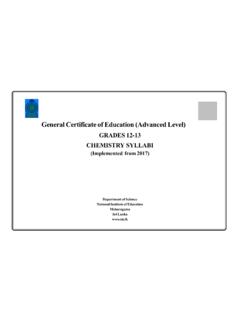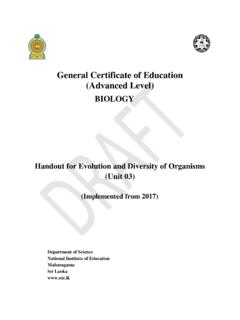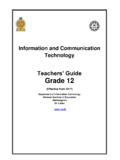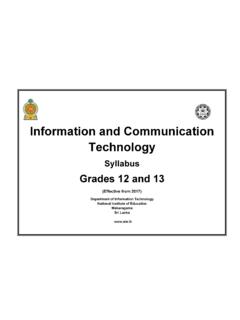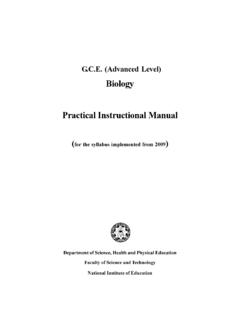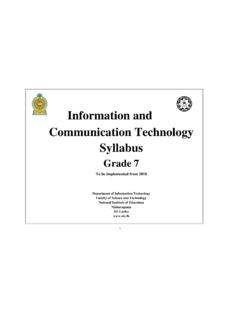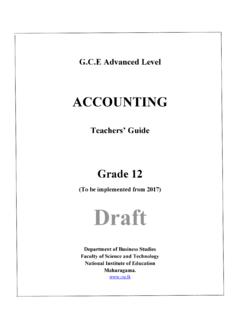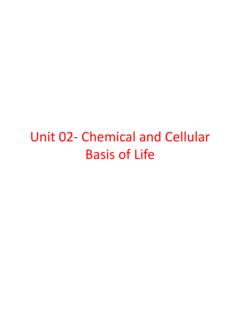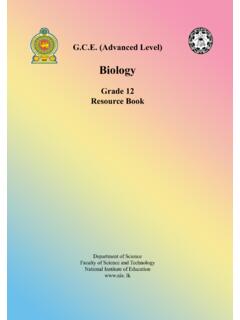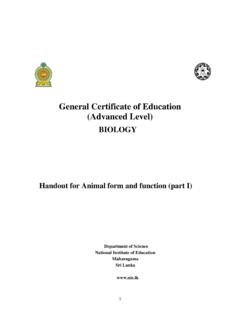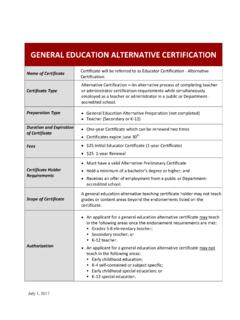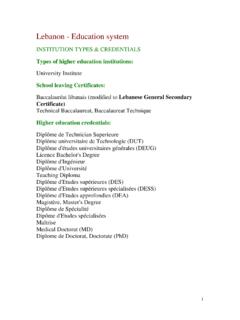Transcription of General Certificate of Education (A/L) - nie.lk
1 IGeneral Certificate of Education (A/L)(Grade 12)Agricultural ScienceTeacher's Instructional Manual(To be Implemented from 2009)Department of Technical EducationFaculty of Science & TechnologyNational institute of Education2010iiAgricultural ScienceTeacher s Instructional ManualGrade 12 National Institute of Education First Printing - 2009 ISBND epartment of Technical EducationFaculty of Science & TechnologyNational Institute of :iiiForewardCurriculum developers of the NIE were able to introduce Competency Based Learning andTeaching curricula for grades 6 and 10 in 2007 and were also able to extend it to 7, 8 and 11progressively every year and even to (A/L) classes in 2009.
2 In the same manner syllabiand Teacher s Instructional Manuals for grades 12 and 13 for different subjects with competenciesand competency levels that should be developed in students are presented descriptively. Informationgiven on each subject will immensely help the teachers to prepare for the Learning would like to mention that curriculum developers have followed a different approach whenpreparing Teacher s Instructional Manuals for Advanced Level subjects when compared to theapproaches they followed in preparing Junior Secondary and Senior Secondary curricula. (Grades10, 11)In grades 6, 7, 8, 9, 10 and 11 teachers were oriented to a given format as to how they shouldhandle the subject matter in the Learning Teaching process.
3 But in designing AL syllabi andTeacher s Instructional Manuals freedom is given to the teachers to work as they this level we expect teachers to use a suitable learning method from the suggested learningmethods given in the Teacher s Instructional Manuals to develop competencies and competencylevels relevant to each lesson or lesson the learning approach the teacher uses it should be done effectively and satisfactorilyto realize the expected competencies and competency would like to note that the decision to give this freedom is taken, considering the importance (A/L) examinations and the sensitivity of other stakeholders who are in the educationsystem to the Advanced Level examination.
4 I hope that this Teacher s Instructional Manualwould be of great help to hope the information, methods and instructions given in this Teacher s Instructional Manual willprovide proper guidance to teachers to awaken the minds of our Lal PereraDirector GeneralNational Institute of EducationivPrefaceAction taken over long years of the past to retain the known and learn the predetermined hasmade us little able today to construct even what is. The first curriculum reform of the newmillennium on secondary Education that comes to being with a drastic change in the learning-teaching process at school level attempts to overcome this inability while bringing about a set ofworthy citizens for the country who are capable of revising the known, exploring the undeterminedand constructing what might you are a teacher teaching this subject or any other subject in grades 6 to 11, it will not bedifficult for you to align yourself with the new learning-teaching approaches that are recommendedin a considerable way for the (A/L) as well.
5 This reform calls the teacher to identifycompetency levels under each competency and plan activities to achieve them. The teachersentering the new role of transformation should understand that the procedures which emphasizethe teacher in the learning-teaching process are of limited use for the present and that it is moremeaningful for the children to learn co-operatively sharing their experiences. This situation,however, requires the teachers to provide a new direction for their teaching by selecting newlearning teaching methods that emphasize the student over the you study the Teachers Instructional Manuals (TIMs) prepared by the National Institute ofEducation for Mathematics, Science, Health & Physical Education , Technology and Commercesubject of grades 6 to 11, you certainly will be able to acquire a good understanding on thestudent-centred, competency based and activity- oriented approaches we have recommendedfor learning and teaching.
6 The activities presented in these Manuals attempt to bring learning,teaching assessment and evaluation on to the same platform and to help you to adopt co-operativelearning techniques on the basis of the 5E the need to establish an innovative teaching force we have selected just a fewactivities from the relevant activity continuum incorporated in the TIMs. Yet we have given youa vast freedom to plan your own activities to suit the subject and the class requirements bystudying the exemplar activities in the Manuals and improving your understanding on the principlesunderlying the reform. The activities incorporated in the TIM, provide you with four types ofinformation.
7 At the beginning of each activity you come across the final outcome that the childrenare expected to achieve through each activity. This learning outcome named as Competency isbroad and long-term. The competency level stated next highlight one out of the number ofabilities that the children have to develop to realize the above explanation shows us that the competency levels are more specific and of a shorterduration when compared to the competency. The next section of the Mannual presents a list ofbehaviours that the teacher has to observe at the end of each activity. To facilitate the task ofboth the teacher and the students, an attempt has been made to limit the number of such behavioursto five.
8 These behaviours referred to as learning outcomes are more specific than the competencylevel. They include three abilities derived from the subject and two others derived from thelearning teaching process. Out of the three subject abilities listed in an order of difficulty, theteacher has to direct the children to realize at least the first two through the exploration. Thenext section of the activity presents what the teacher should do to engage the children for theexploration. Although the implementation of each and every activity starts with this step ofvengagement, the teachers should not forget that activity planning should begin with the explorationwhich is the second E of the 5E for the group exploration from the next section of the exemplar activities the teacherplans these instructions in such a way to allow different groups studying different facets of thesame problem to reach the expected ends through a variety of learning-teaching methods.
9 Forthis, further the teacher can select either Inquiry-based Learning carried out through a series ofquestions or Experiential Learning where children learn by doing. It is the responsibility of (A/L) teacher to use the knowledge that the children acquire by any of the above methodsto solve problems that are specific to the subject or that runs across a number of subjects of thecurriculum is meaningful to plan such problem-based learning-teaching methods on the basis ofreal-life situations. For this you can select dilemmas, hypothetical situations, analogies or primarysources. Some techniques that can be used for the explorations are reading, informationmanagement, reflection, observation, discussion, formulation and testing of hypotheses, testingpredictions, preparing questions and answers, simulation, problem solving and aesthetic activitiessuch as drawing or composing.
10 There is room here even for memorization although it is consideredas a form of mechanical students explore in small groups. Instead of depending on the knowledge available to theteacher, they attempt to construct their own knowledge and meaning with the support of theteacher. Moreover, they interact with others in the group to learn from others and also to improvethe quality of their exploration findings. All this works successfully only if the teacher is capableof providing the students with the reading material and the other inputs they are in need of. Theteacher also has to support student learning throughout the learning process by moving from onegroup to another.
